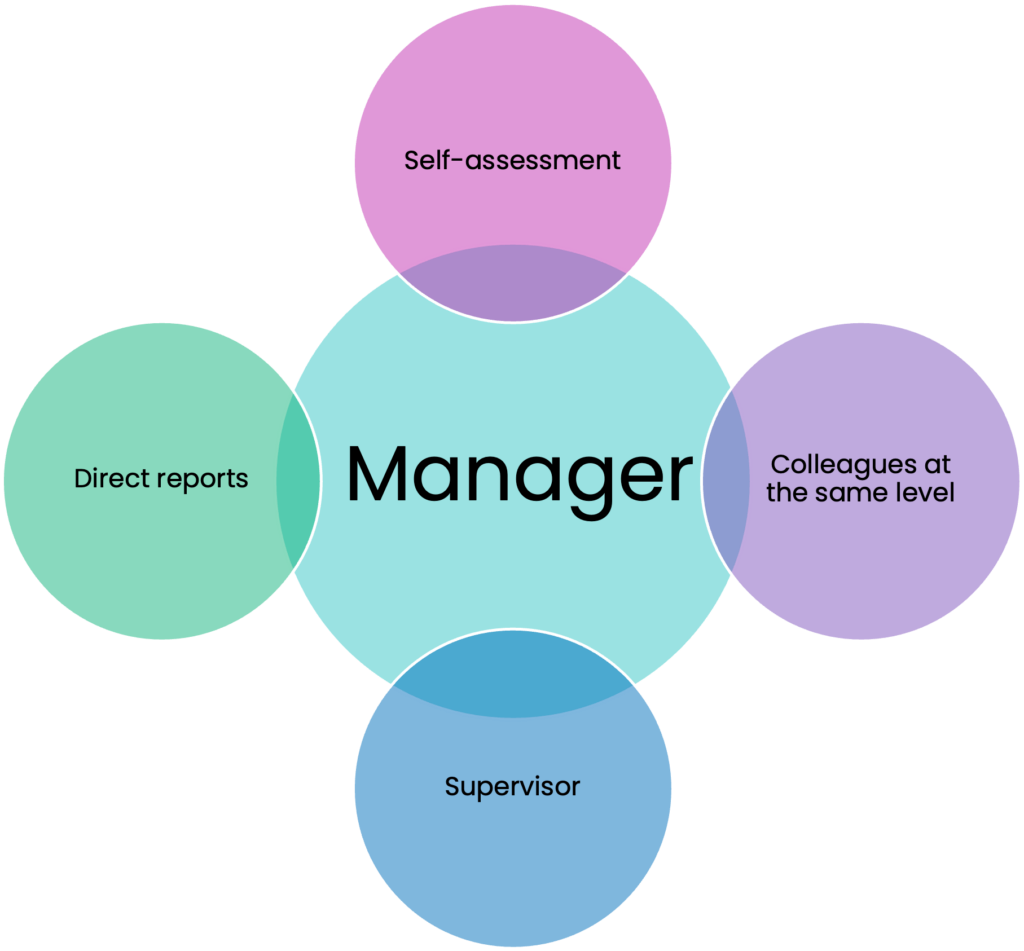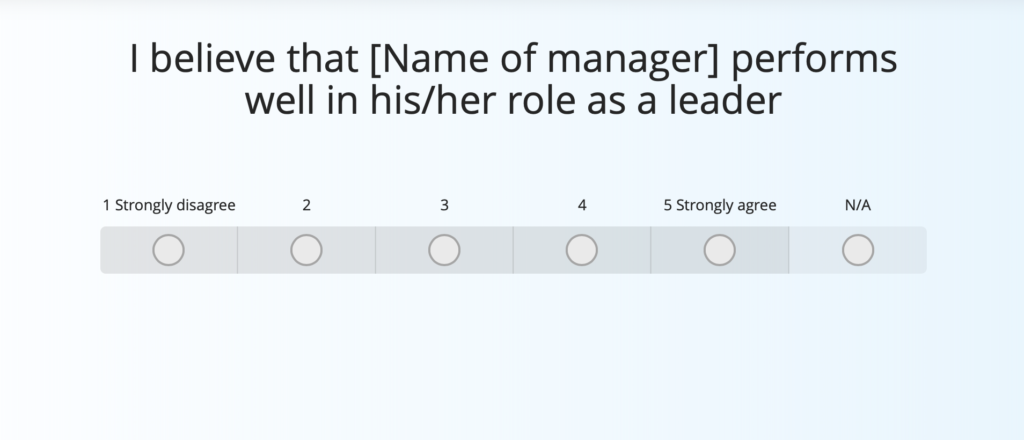Table of Contents
360 degree feedback example questions
When making important decisions, you cannot solely rely on a gut feeling. A 360° survey can help you get a clearer picture, from multiple angles, to support your empirical observations with data. In this article, you will find a collection of 360 degree feedback example questions that you can use in your 360° surveys throughout the year, whenever a comprehensive evaluation is required.
Preparing your 360-degree feedback questionnaire

If you want to learn a bit more about what 360-degree feedback is first, we recommend having a look at: Definition, variants and advantages of 360-degree feedback.
360 degree reviews can be tricky to get right. If you’re asking a group of colleagues for their feedback about a particular employee, you need to be sure to create questions that work across the workplace hierarchy.
Furthermore, all organisations have unique values and characteristics, so you should always adjust your feedback forms to suit yours, which you can achieve by using the right 360 degree feedback software and adapting templates to suit individual needs. And consider that these 360 degree feedback sample questions are more of a guide than a set-in-stone template of how to carry out such review. For an example of a case study, have a look at how the Munich Leadership Group uses Netigate for its 360° evaluations.
Because 360 reviews are traditionally anonymous, a 360 degree feedback questionnaire (and ranking scale from 1 to 5) should help keep the feedback laser-focused and constructive. We recommend avoiding open-form questions, which sometimes lead to personal or ad hominem comments. If qualitative feedback is necessary, however, make sure reviewers know that feedback could potentially be linked back to them.
When distributing 360 degree surveys, be sure to add a detailed explanation of who is being reviewed and what type of feedback is desired. For example:
Please find the attached questions for the 360 Review for “Employee X.” Respond to the questions below by providing a ranking on the scale based on your individual interactions with the employee.
These answers will be combined with the remaining feedback to build a complete picture of Employee X’s leadership, communication, interpersonal, problem-solving, and organisational skills.
360 degree feedback example questions
Let’s have a look at some topics to cover through our 360 degree survey examples for managers.

Leadership skills
- Does the employee take the lead on projects or assignments?
- Is the employee a motivating force in the team?
- Does the employee put aside their own ego and ambition when it comes to team projects?
- Does the employee value accountability and take responsibility for project outcomes?
Communication skills
- Does the employee communicate well with their fellow employees?
- Is the employee open to receiving feedback from peers?
- Does the employee not only actively listen but also seek clarification on areas they don’t understand?
- Does the employee communicate well outside of their department?
Interpersonal skills
- Does the employee collaborate well with their colleagues?
- Has there been any conflict between the employee and other members of the team?
- Does the employee recognise or praise colleagues for their accomplishments?
Problem-Solving skills
- Is the employee able to work autonomously (i.e., without direction from a manager)?
- Is the employee decisive when it comes time to choose a direction?
- Does the employee react quickly to unexpected challenges or obstacles?
Organisational skills
- Is the employee aware of the organisation’s top goals?
- Does the employee live our company values every day?
- Does the employee keep the customer front-of-mind?
Motivation
- Is the employee dedicated and motivated?
- Does the employee show their motivation to others?
- Is the employee able to motivate others?
Alignment of values
- Is the employee aligned to the company’s values in their work ethic?
- Does the employee work towards the company goals and visions?
- Is the employee able to communicate the company values to others?
- Is the employee involved and committed to aligning new ideas with the company values?
These 360 degree feedback example questions will help you to supplement your ongoing performance review processes and overall employee experience. Keep in mind that 360 reviews, if done poorly, can be a misuse of resources. That’s why it’s important to maximise these opportunities to provide your organisation with the best possible data. But if you have an organisation that values continuous improvement and professional development, then 360s are a must in your HR toolkit.
We can manage your 360 degree feedback projects for you. Read more here.
Room for comments
In addition to the sample questions focussing on the core competencies of your managers, leave room for further feedback. Some questions may require follow-up boxes, where the evaluating employees can leave comments or remarks. This can be a dedicated space to elaborate on and highlight certain strengths or weaknesses. It will help you to get a clearer picture that adds on top of the scaled data. However, be aware to include the guidance we mentioned above: that comments may be traceable to the respondents via the context, for instance. Ensure to communicate that feedback needs to be constructive.
The purpose of a 360 degree evaluation
360 reviews solicit input from fellow employees, managers, and direct reports. The result is a more balanced snapshot of an employee’s skills as a colleague, leader, or manager. Unlike the traditional performance reviews, 360 degree feedback captures and assesses an employee’s development— particularly in a team setting. As Mark Åström notes, a 360 degree feedback questionnaire is not a performance tracker per se. Instead, it provides a thorough look at the employee’s strengths and how they fit into the company as a whole. It’s a vehicle through which you can give constructive feedback that benefits the individual and the company.
Try Netigate EX, our brand new employee engagement tool.
It’s important to carefully consider the goal of 360 degree reviews you conduct. I recommend that clients don’t view 360 reviews as a performance measurement but as a blueprint for an employee’s development.
Mark Åström, Netigate’s Senior Technical Project Manager.
You therefore want to use a 360° survey to check the company culture as a whole. Leadership is an important driver for employee engagement in general, so it needs to align with the company values. While you thus uncover strengths in your managers, a 360 feedback evaluation also help to identify gaps, blind spots, and weaknesses that may have gone unnoticed. It provides the opportunity to work with leadership together to create a better overall engagement, work environment, and further long term development.
360-degree feedback can complement, and be complemented by, your existing feedback processes. This means that you can contextualise the data with employee satisfaction surveys or employee engagement surveys.
Interested in your own 360 degree feedback survey, but not quite sure how to start? Contact us via our contact form or start your free 30 day trial to use our 360 feedback templates.
-
Netigate Marketing
-
Netigate Marketing
- 5 min read
- .







 Copyright © 2025 Netigate AB, Drottninggatan 25, 111 51, Stockholm, Sverige
Copyright © 2025 Netigate AB, Drottninggatan 25, 111 51, Stockholm, Sverige